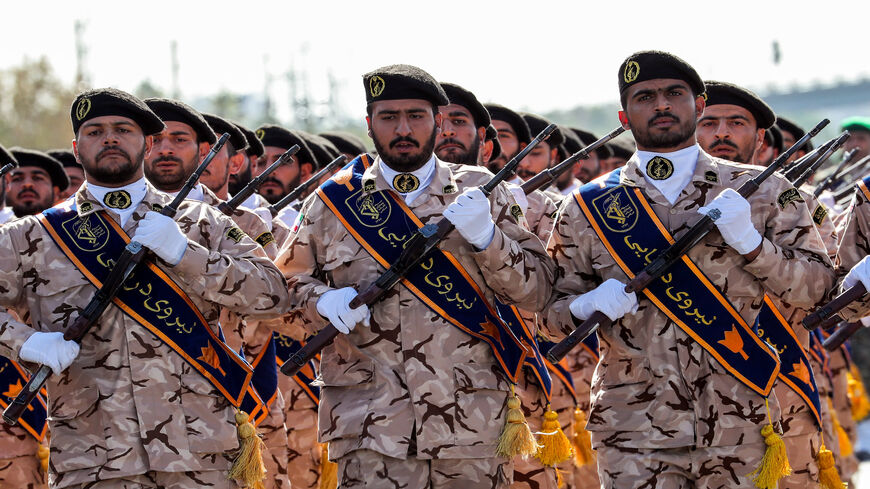
The future of Iran’s presence in Syria seems to be dividing the Syrian leadership.
Until a few weeks ago, he was among the strongest men in Syria — if not the strongest — but Javad Ghaffari’s last battle in the war-torn country was this time with no one other than the ruling elite he came to the country to defend.
“He became a liability,” an official Syrian source told Al-Monitor on condition of anonymity. “The time has changed, and he still wants to act as per the rules of war, when the war is almost over.”
The Iranian general, whose real name is Ahmad Madani, was appointed as head of the Islamic Revolutionary Guard Corps (IRGC) forces in Syria in 2015 to succeed Maj. Gen. Hussein Hamadani. Hamadani laid the foundation for the Iranian intervention in Syria and was killed in October 2015 in Aleppo by the Islamic State, according to what the IRGC announced. However, nonofficial accounts cast doubt over his death suggesting it was a car accident, and some Iranian websites claim it was an assassination.
Ghaffari was the choice of IRGC Quds Force’s slain commander Maj. Gen. Qasem Soleimani, a source close to the Quds Force told Al-Monitor. The source said that there was a main hurdle preventing his appointment — Ghaffari’s marriage to a non-Iranian woman. “Soleimani took him to Tehran to meet the supreme leader and secured him an exception,” the source said.
During his six years as commander of the IRGC’s Quds Force in Syria, Ghaffari oversaw the main stages in the fight. He was present in all the battles, helped form the National Defense Forces in 2013 and was strong enough to nearly sabotage a deal between the Russians and the Turks to evacuate opposition fighters from eastern Aleppo, when he asked his fighters to shoot at the buses because the evacuees from the Shiite villages of Kfarya and Foa where not allowed to leave.
Syrian opposition media outlets describe him as “the butcher of Aleppo,” while those who admire him call him “the liberator.” But regardless of both sides’ assessments, he was regarded by the Syrian regime and the Russians as a troublemaker who was not ready to compromise his power and influence for any price.
“He was another Qasem Soleimani,” said the Syrian source. “His calculations are more about what he sees as Iran’s interests, and this is not by all means what Iran might want.” The source added that Ghaffari’s mentality made him a liability that everyone agreed should go.
But on the contrary to earlier reports, multiple sources from both the Syrian and Iranian sides told Al-Monitor that the decision to dismiss Ghaffari was taken by mid-October, a few days before the attack on al-Tanf garrison and three weeks before the visit of UAE’s Foreign Minister Abdullah bin Zayed to Damascus.
“The decision to dismiss Ghaffari came upon a request from President Bashar al-Assad, who sent a message to the Iranian leadership asking them to take this step in order to preserve the strong ties between the two countries,” the Syrian source said. He explained that this was more of a step to prevent cracks in the relationship between the long-time allies.
“They first pushed for the redeployment of forces from the Sitt Zainab area near Damascus airport highway,” the source noted. “Eventually, this request came from outside the borders, and there were other demands such as for the Iranians and their allies to leave Damascus completely. In addition, relations should from now on go through the embassies, but they never made this request officially — at least for now.”
The future of Iran’s presence in Syria seems to be dividing the Syrian leadership, Al-Monitor’s sources note. There is one camp that is very cautious and insists on showing appreciation and respect to the Iranians for what they did during the past decade. They do not want to pressure them to redeploy, whatever the circumstances are. This camp is led by Assad, some of his advisers and several military officials.
The second camp wants the Iranians and their allies to accept that the war in Syria is over and there is no need for their presence. Among the prominent members of this camp are first lady Asma al-Assad and Gen. Maher al-Assad, the president’s younger brother and commander of the notorious Fourth Division. A Syrian official source who spoke to Al-Monitor stressed that the regional polarization made its way into Damascus’ top elite that is now bracing for the rebuilding process, which is seen as a mandatory direction toward what they regard as reconciliation and sustainable peace.
What is obvious is that Iran will not sacrifice its relations with Syria even if that meant changing one of its strongest commanders in the region, or even redeploying forces. But it is also clear that after 10 years of fighting in Syria to prevent Damascus from slipping out from the “resistance axis,” it is very unlikely that Tehran will allow this to happen in times of ease. What is unclear right now is what options Iran has at its disposal and whether the moves in Damascus have anything to do with de-escalatory moves, especially since a regional dialogue is happening in Baghdad, and despite all the circumstances those overseeing it are still optimistic about its outcome.
